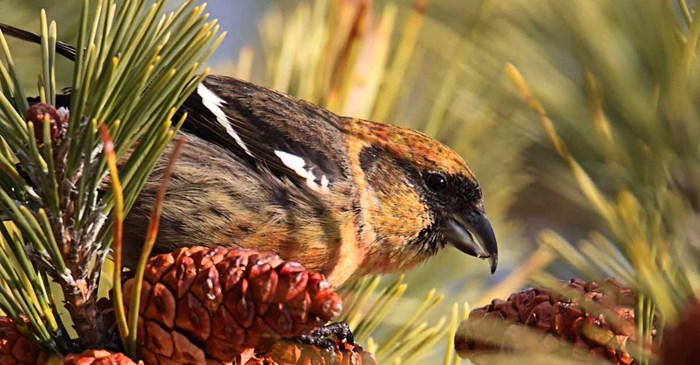Beak shape reveals much about a songbird’s diet, and that’s especially true for the White-winged Crossbill.
The pointy ends of this finch’s stout beak extend a bit, making the upper and lower mandibles cross over. It seems this would be a rather uncomfortable and awkward beak shape to live with. But for the White-winged Crossbill, a crossed beak serves a purpose. It’s a tool that lets them pry open the cones of spruce and tamarack, so they can get at the delicious seed inside, their main source of food. Once they remove it and break open the seed husk, they swallow it whole. Eating small amounts of grit helps them digest the seed.
Read What Beak Shape Reveals About A Bird's Diet
Where do White-winged Crossbills live?
Their diet depends on the seeds of spruce and tamarack, so White-winged Crossbills live and thrive mainly in the conifer forests of the far northern U.S. as well as Canada. They also eat insects, fir seeds, and the occasional bud from a deciduous tree.
White-winged Crossbills are nomadic irruptive migrants, which makes their location and movements difficult to track and predict. When crops of spruce and tamarack cones are low, they’ll leave their home territory. Birders have spotted them gathered up at spruce stands at city parks, arboretums, campuses, and other places where spruce are planted. If your bird channels are talking about an irruption of White-winged Crossbills, those are some places to look.
Fun facts about the White-winged Crossbill
- Did you know there are more "right-beaked" crossbills than left-beaked? Birds that have the lower mandible crossing to the right are three times more common than those with a left-crossing lower mandible.
- White-winged Crossbills have been observed nesting and raising young across all 12 months of the year — not just springtime. This species is an opportunistic breeder, which means they act when the food supplies are adequate and can provide the female with the nutrients to create eggs.
- Once the babies fledge, the males take care of the young birds alone. Researchers believe females are off with a new male partner to raise a second brood. (Redpolls and American Goldfinch also do this.)
- White-winged Crossbills live in flocks year-round to forage in the treetops, even when they’re in the midst of a breeding season. As they take on the focused work of prying open spruce cones, being surrounded by other birds provides a layer of safety against predators.
If your area experiences an irruption of White-winged Crossbills, they will visit bird feeders, especially in locations near a stand of spruce. Keeping your feeder filled with a high-quality mix that attracts finches, such as Lyric Finch Mix is a great way to draw in crossbills and other colorful visitors.
